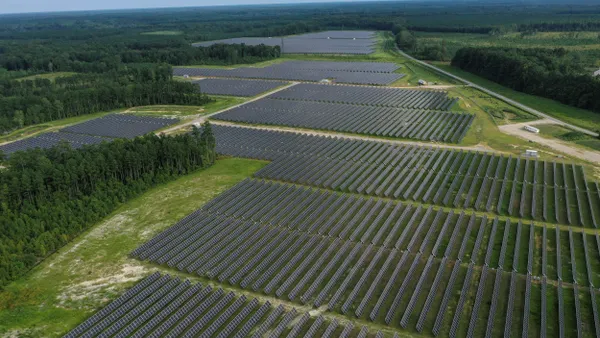Dive Brief:
- Duke Energy filed a proposal last month with North Carolina regulators to solicit an additional 700 MW of new solar capacity within North Carolina and South Carolina, bringing its total planned solar solicitations in the Carolinas to more than 1,300 MW this year.
- The plan, announced on Friday but submitted on March 14, is in addition to roughly 600 MW of solar projects in a separate Competitive Procurement of Renewable Energy program. That previous CPRE program, a process for adding renewables developed by North Carolina in 2017, is currently in the last round of bidding.
- The utility must supply 45% of its new solar generation through power purchase agreements with companies within North and South Carolina, in accordance with North Carolina's carbon reduction law, H.B. 951.
Dive Insight:
States that are not under an independent system operator or regional transmission organization have been working in recent years toward more competitive resource procurement, experts say. Duke's latest procurement proposal is based on a specific carveout to ensure competition in nearly half of the new solar resource additions in the state.
For example, Washington, Utah and Arizona have considered rules that require all-source procurement, a requirement for capacity or generation resources that includes a full range of resources as well as potential combinations of available resources in the market. More states, in conforming with the Public Utility Regulatory Policies Act (PURPA), are creating opportunities for resource competition from third-party solar developers, although some regions, including the Southeast, tend to be more prescriptive in their solicitations, according to Autumn Proudlove, senior policy program director of the North Carolina Clean Energy Technology Center.
"Even in states like North Carolina, because of PURPA rules, there was a ton of development opened up for competition," Proudlove said.
H.B. 951, enacted in October, allows for 55% of Duke's solar generation to be company-built, while also mandating a set amount be acquired through a solicitation process, allowing for third-party access to commercial-scale development.
While the new solicitation will only be open to outside parties, to meet the 45% carveout for third-party owned solar, past CPREs have been open to all companies, and Duke's regulated and commercial subsidiaries had won projects in those solicitations.
"So I’d say we’re just as competitive as other companies in building solar," Duke spokesperson Randy Wheeless said in an email.
The two solicitations this year would add nearly 24% to Duke's solar power capacity in North Carolina, as the company already has 4.2 GW of solar in the state.
The North Carolina Utilities Commission must take reasonable steps to achieve a 70% reduction from 2005 levels of carbon dioxide emissions in the utility sector by 2030, and regulators are expected to approve a series of annual solar procurements beyond the 1.3 GW currently proposed.
"Just opening up regions to competition goes a long way" towards lowering costs, Proudlove said.
According to Duke, a quick order from the NCUC could create an open window for bids as early as May 31 through July 15, with winners announced in early 2023 and projects coming online in early 2026.














